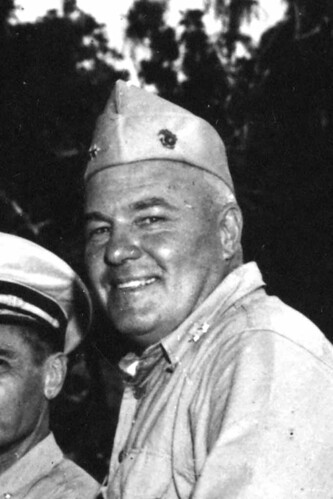First post-war governor
Henry Louis Larsen (1890 – 1962) was a lieutenant general of the US Marine Corps, and was the governor of Guam from 15 August 1944 to 30 May 1946. His major mission of World War II was as Island Commander. He was in charge of some 215,000 personnel on Guam, directing the largest single construction project in the history of the US Navy, the transformation of an undeveloped island into a major base for fleet and air operations during the war.
He was born in Chicago, Illinois on 10 December 1890, and spent his childhood in Chicago and Denver. He entered the US Marine Corps at age twenty-three and served in France during World War I. After the war he saw service at some US posts as well as in Samoa and the Caribbean. He also served at sea aboard battleships and cruisers.
Prior to the outbreak of World War II he served at US Marine Headquarters in Washington, DC as director of plans and policies, and was responsible for wartime expansion of the Corps. After the Pearl Harbor attack he was ordered to Samoa as commander of a reinforced brigade made up of the first combat troops to leave the continental US President Franklin D. Roosevelt appointed him first military governor of American Samoa on 15 January 1942.
In June 1943 he became commander of Camp Lejeune, North Carolina.
Assumed command of Guam on Liberation Day
He began his assignment as Island Commander of Guam on 21 July 1944 when the Marines landed to begin their campaign to recapture the island from the Japanese. As such he was the first military governor of the island following the cessation of hostilities. However, the day-to-day administration of the government was handled by a Commander James Barton, who served as Larson’s deputy chief military government officer.
Larsen primarily concerned himself with building Guam as a key forward base. There were eighteen engineering and construction battalions and many military support groups, working day and night on Guam during those days, as World War II was still raging in Asia. By early 1945 five large air bases and eight air strips were in operation at Orote, Halaguag (now Guam International Airport), Finegayan (Harmon Field), Machanao-Finaguayoc (Northwest Field) and Upi (now Andersen Air Force Base). Planes flew daily from these airstrips to bomb targets in Japan.
The port was also a busy place as well. Sumai, Orote, Apla, Apra Harbor and the surrounding lands were moving cargo at a rapid pace. The marines were encamped at various places around the island, including the villages of Yona, Orote, and Ipan, Talo’fo’fo. Army posts, too, were scattered from the villages of Hågat to Yigo, as were the military Seabees. Field hospitals were located in the south, central and north of Guam, treating wounded troops from the invasion forces in Iwo Jima and Okinawa, Japan.
In May 1946, Larsen left Guam and assumed his final assignment as Commanding General, Department of the Pacific. Having been especially commended for heroism in combat, he was advanced to lieutenant general on his retirement on 1 November 1946, having served thirty-three years in the Corps.
After his military career he was appointed by Governor Daniel Thornton as Colorado’s civil defense director, a position he held until his retirement in 1959. Larsen died in October 1962.
For further reading
Patterson, Michael Robert. “Henry Louis Larsen, Lieutenant General, US Marine Corps.” Arlington National Cemetery, last modified 9 June 2006.
Rogers, Robert. Destiny’s Landfall: A History of Guam. Honolulu: University of Hawai’i Press, 1995.




